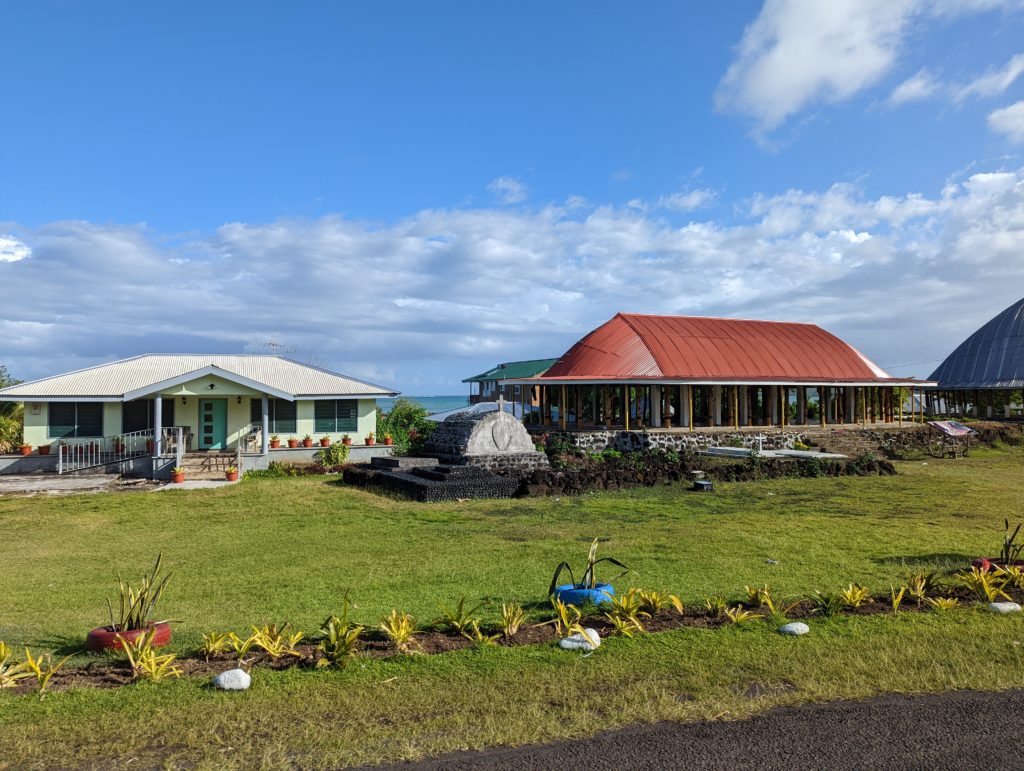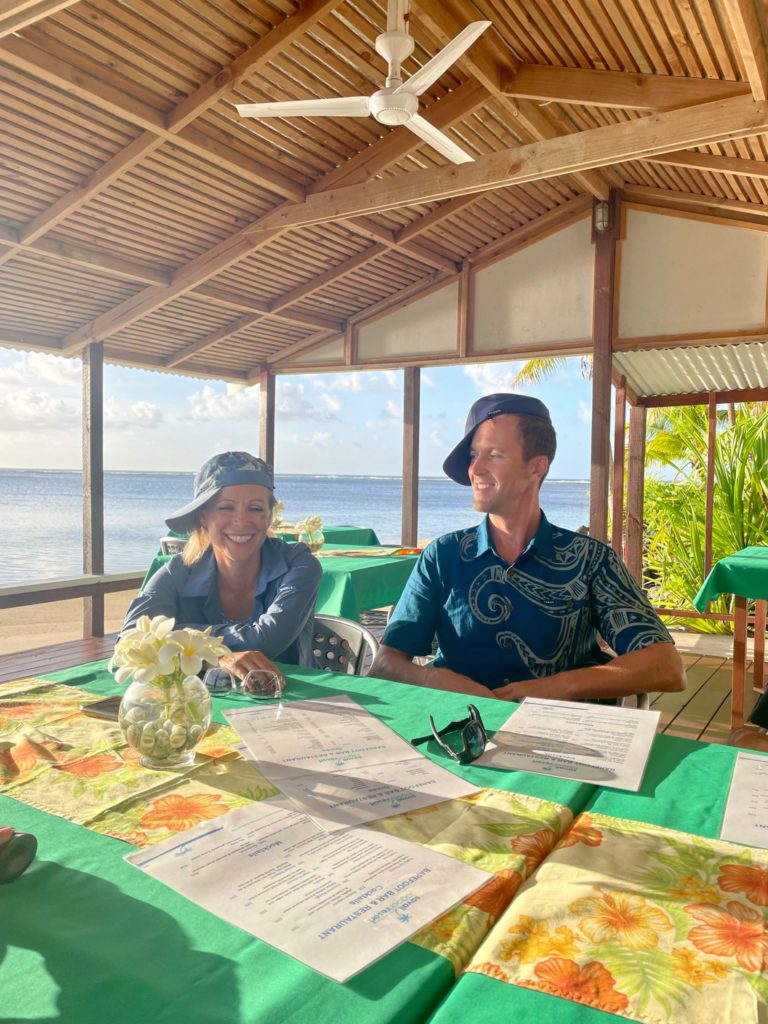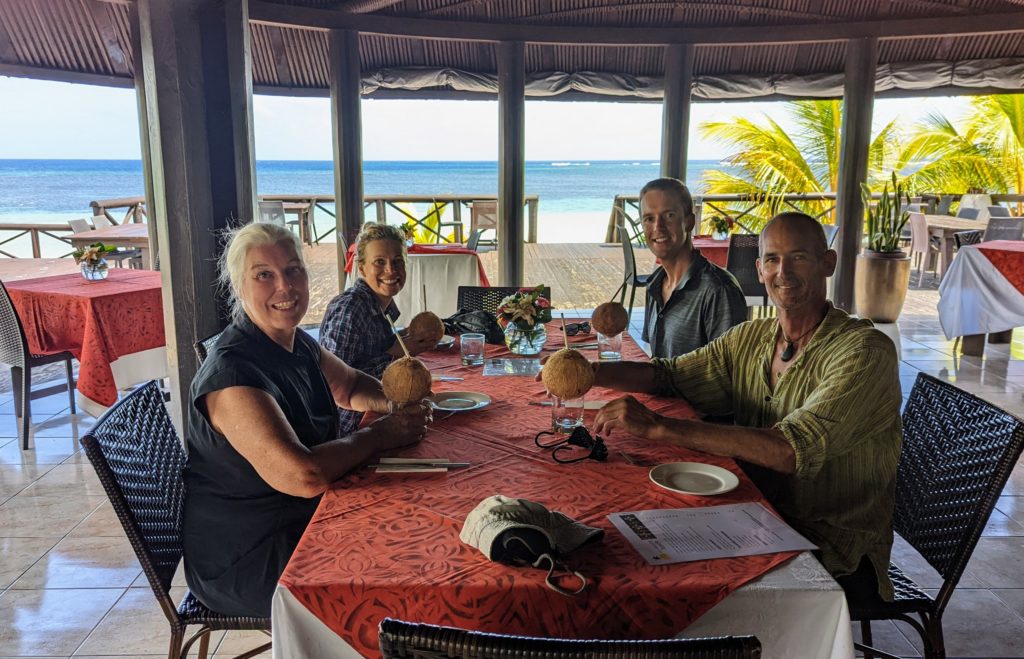We sailed over to Savai’i from the airport anchorage of Upolu, a nice pleasant day sail. We anchored in a little bay called Matautu, followed closely by Acushnet and Ten Gauge, who had finally gotten their cruising permit. (By parking themselves in the office and cheerfully but obstinately waiting.) This brought the total number of permits issued to four, the first having gone to a super-yacht with a “sea scientist” [sic] on board. The bay is both pretty and easy to anchor in, with a big flat sandy shelf surrounded by sharp reef walls.





Having landed, we made a couple of phone calls to try to get a rental car. The option, instead, turned out to be a tour, which was better because the big van was able to accommodate six. So first thing the next morning, Acushnet, Ten Gauge, and Villa Veritas headed into shore, braving the shallow reefs to beach our dinghy outside a pair of resorts. Once there, we learned that the driver had never gotten confirmation that we were coming. Savai’i Lagoon Resort had his number and sorted things out, so in just a few minutes we were loaded up and on our way.

The first stop was the Saleaula lava fields. A slow eruption in 1905-06 had left ripples of lava all along the coast. It’s particularly dense in this area, where the lava flowed through a stone church.







The flow continues all the way to the ocean.


The other notable attraction here: a “virgin’s grave”, where the lava flowed around the burial site of a young girl, “sparing her” because of her “purity”. Which girl? Her name is not featured.



The site also had a sign advertising their Garden Toilet. We saw lots of these signs, which at the time we just found amusing, and which we later found referred to public toilets built by the National Beautification Committee and Samoan Tourism Authority as a public health measure. Despite these existing, when our group needed a restroom break, the driver stopped at a hospital instead.

We made a quick stop to check out this church, built out of hewn coral bricks, and to descend into this lava tube. The inside was cool and dark, with a couple of bats.


Speaking of bat-like things, we stopped by the side of the road to look up at this tree, which was full of loudly chittering flying foxes.


By this point there had been some driving around, and it was getting on towards afternoon. We asked the driver what the plan was for lunch, as we drove past a likely-looking resort restaurant. We’re not sure he understood the question, because we stopped at a gas station and he encouraged us to get some bao. Is this lunch, or just something to tide us over? Instructions unclear, we bought some bao, which were tasty but which, we would find out the following day, were maybe not the most digestively compatible. This is not where we stopped, but a little later, when school presumably broke for lunch and uniformed kids swarmed all the roadside shops.

Our next tour stop was the most famous site in Savai’i, the Alofaaga blowholes. This was, we were told, a relatively tame day, but we were still pretty impressed by the speed and volume of water that the waves shot into the sky. The thing to do is to throw a coconut in, but we didn’t try it.




This dog served as our tour guide, and was absolutely loving his life. Ross fed him some rejected fish and chips, which put an extra shine on what was obviously already a fantastic day for the little guy.


There’s nothing preventing you from just walking down onto the beach, but someone had helpfully built a nice raised viewing platform, safely out of range of all but the lightest mist of sea spray. We were driving on when we noticed the guy on the right shooting up the trunk of this coconut tree with a machete.


By this point the ambiguity around lunch had us a little low-energy. Every stop entails a nominal fee; we knew this in advance, but when the driver told us there wasn’t much water in the waterfall and asked if we wanted to go anyway, it was somehow not a foregone conclusion. After dithering for a few minutes, we decided to forge ahead and pay the tala, and we were rewarded with the best stop of all. The Afu Aau waterfall was indeed not robustly falling, but the pool was clear and beautiful. We swam, we climbed into the trickling falls, we jumped off a ledge, and we emerged feeling refreshed and clean.












This was the last official tour stop, but we had a decent drive ahead of us to get back to Matautu, and the driver asked if we wanted food. We very much wanted food. So he drove us towards the Salelologa wharf, in the center of the island’s main town, and we figured we were going to a local restaurant. Instead, we pulled up to what turned out to be a fast food shop directly opposite the wharf. The ferry was arriving, which meant that all the busses on the island were filling up with passengers, and we delayed our dance with fried chicken to take pictures of some of the choicer decorations. Lucinda, from Ten Gauge, was excited to find a bus with her name on it.



Eventually we went inside, where we eschewed the offered instant noodles in favor of fried chicken and miniature spring rolls. Sadly the soft-serve machine was broken, though not as badly as the toilets.


Some highlights from the drive back: as in neighboring Upalu, the Samoans of Savai’i build lots of big fales for meetings and gatherings, and bury their important relatives in front of them. Each family has one, and only the families with the big round ones are eligible to have chiefs. Our driver informed us that due to COVID restrictions, the ceremony in which chiefs were voted in had not been held in years. He was certain that he was going to become his family’s chief during the next ceremony. (He mentioned elections, but there didn’t seem to be any uncertainty surrounding his rise to power.)


The tradition of decorating the side of the road also continues on this island, which is very clean and well-maintained. It turns out that this is not a coincidence. The men hold the votes for chiefs, but the women’s committees organize garden and house inspections, in which they walk through the village in a big group and say catty things about the yards and houses that aren’t being properly cared for. This seems to provide sufficient incentive. All of this information provided by our driver slash tour guide; veracity unconfirmed except by the clean streets.


There are also a lot of freshwater springs around the coast, which historically were the water source for the islanders. So you see lots of stone structures built around the springs, sometimes with separate areas for drinking water and bathing, before the overflow makes its way into the ocean. Upon arrival, the resort had warned us that the water was, by and large, not safe to drink here, and we imagine this is what they meant. But we also saw at least one UN-installed UV sanitizing faucet, so it seems there is progress.

We made it back to Savaii Lagoon Resort a little early for the dinner we’d promised the manager in payment for use of their beach. So we sat down, ordered drinks, and took some appropriate precautions against the still-bright setting sunlight.



Andrew and Ross ordered a particularly milkshake-like cocktail, and were very happy.



Jazz’s was prettier, though. We were treated to an excellent sunset and a decent dinner, and made it back across the reef without incident.



The next morning, we had a few hours before the right timing to leave for Wallis, so Andrew tried our our new laundry wringer stand. The results: we nailed it, and only some seven months after ordering the wringer, we have a working laundry situation. Captain, oblivious to our toil, spent the morning napping.



Before we took off, we braved the reef one last time to visit the other resort, Le Legato, for a parting lunch with Ten Gauge. The setting was prettier, but the food was not as good as next door. At least the company was good, and Lucinda was willing to buy out the last of our Tala.



Even better, she agreed to take a postcard to the post office for us, which we later found was a saga:

Ah, Samoa. Beautiful country, but oh the bureaucracy.
